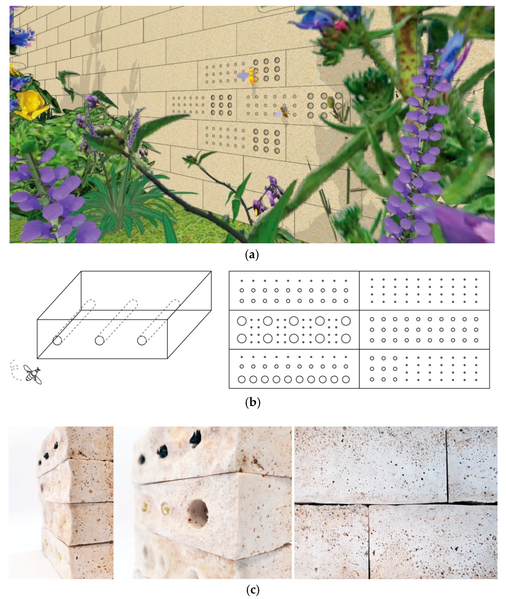Biocement

|
| This series of figures illustrates a biocement application in bee nesting. Figure (a) shows a virtual diagram of the biocement brick and housing area. Figure (b) shows the cross section of the design and the holes the bees can nest in. Figure (c) shows the prototype of the bee block made from biocement. |
Contents |
[edit] Introduction
Biocement is a product that stimulates native soil bacteria to connect soil particles through a process known as microbially induced calcite precipitation (MICP). It uses microorganisms to produce a strong and renewable building material with minimal impact on the environment. Compared to the production process of traditional cement, biocement uses less energy and generates less CO2 emissions.
[edit] Development of biocement
MICP produced biocement is shipped as a dry powder that is mixed with water. This process - referred to as biocementation - results in a product that may serve as an appropriate substitute for cement in construction projects.
Using bacteria to generate calcium carbonate precipitation incorporates several chemical reactions, including the hydrolysis of urea. This has become one of the most commonly used processes for the production of biocement in terms of cost and time.
There are several suggested uses for MICP biocement, including crack remediation, concrete corrosion moderation and biogrout (a soil improvement method) production.
[edit] Self-healing biocement
Biocement has also been used in self-healing applications. In this procedure, water is used to activate the bacteria to react materials. for sealing cracks, filling pores and bonding surfaces with bacterial calcium carbonate deposits. It offers durability, leak prevention and extends the service life of concrete structures.
Oxygen is consumed by the bacteria to convert calcium into limestone, which closes the crack and helps in the prevention of the corrosion of steel reinforcement due to water ingress.
This technique may prove useful in the preservation or conservation of structures built from porous materials. Buildings, monuments and other vulnerable objects may be especially susceptible to moisture, chemicals, pollutants and other contaminants that have an impact on their strength and appearance. The success of the process may depend on several environmental factors, including weather conditions and pH levels.
[edit] Biocement bricks
Biocement bricks are another product that can be 'grown'. Instead of requiring a significant amount of heat in the production process, these bricks are created by using a bacterial byproduct to fuse sand particles together and form a durable building material.
This technique was developed by bioMASON, a North Carolina company founded by architect Ginger Krieg Dosier. These durable bricks use a combination of biomass, aggregate, renewable nutrients and minerals that are placed into moulds and then treated with a type of bacteria (Sporosarcina pasteurii) that is fed with calcium ions and water. This results in the production of a calcium carbonate shell that can be used to create a 'natural' biocement brick. The process takes less than three days and is said to simulate the actions used by corals.
In a Wired article entitled, How to grow bricks from trillions of bacteria, Kathryn Nave writes: ‘A single bacterial brick takes two to five days to grow, compared with three to five days to make a kiln-fired version. “We can make bricks that glow in the dark, bricks that absorb pollution, bricks that change colour when wet," Dosier says.’
[edit] Related articles on Designing Buildings
- Artificial cement.
- Cement.
- Concrete.
- Cradle-to-cradle.
- Cradle to cradle product registry system.
- Self-healing concrete.
- Self-healing concrete and sweaty roofs: is this the future of buildings?
- Regenerative design.
[edit] External resources
- Kathryn Nave, Wired, How to grow bricks from trillions of bacteria.
Featured articles and news
Government consultations for the summer of 2025
A year of Labour, past and present consultations on the environment, the built environment, training and tax.
CMA competitiveness probe of major housing developers
100 million affordable housing contributions committed with further consultation published.
Homes England supports Greencore Homes
42 new build affordable sustainable homes in Oxfordshire.
Zero carbon social housing: unlocking brownfield potential
Seven ZEDpod strategies for brownfield housing success.
CIOB report; a blueprint for SDGs and the built environment
Pairing the Sustainable Development Goals with projects.
Types, tests, standards and fires relating to external cladding
Brief descriptions with an extensive list of fires for review.
Latest Build UK Building Safety Regime explainer published
Key elements in one short, now updated document.
UKGBC launch the UK Climate Resilience Roadmap
First guidance of its kind on direct climate impacts for the built environment and how it can adapt.
CLC Health, Safety and Wellbeing Strategy 2025
Launched by the Minister for Industry to look at fatalities on site, improving mental health and other issues.
One of the most impressive Victorian architects. Book review.
Common Assessment Standard now with building safety
New CAS update now includes mandatory building safety questions.
RTPI leader to become new CIOB Chief Executive Officer
Dr Victoria Hills MRTPI, FICE to take over after Caroline Gumble’s departure.
Social and affordable housing, a long term plan for delivery
The “Delivering a Decade of Renewal for Social and Affordable Housing” strategy sets out future path.
A change to adoptive architecture
Effects of global weather warming on architectural detailing, material choice and human interaction.
The proposed publicly owned and backed subsidiary of Homes England, to facilitate new homes.
How big is the problem and what can we do to mitigate the effects?
Overheating guidance and tools for building designers
A number of cool guides to help with the heat.
The UK's Modern Industrial Strategy: A 10 year plan
Previous consultation criticism, current key elements and general support with some persisting reservations.
Building Safety Regulator reforms
New roles, new staff and a new fast track service pave the way for a single construction regulator.

























